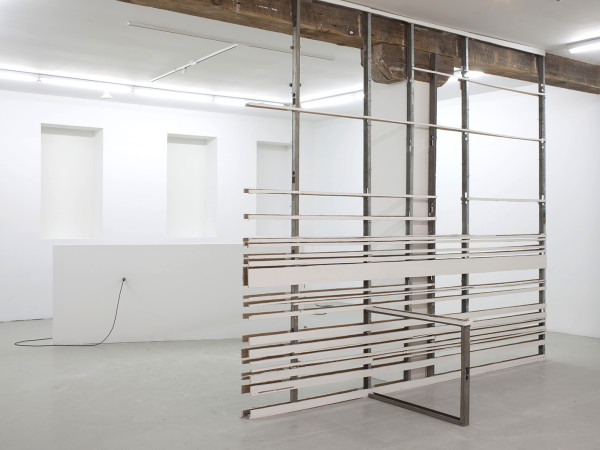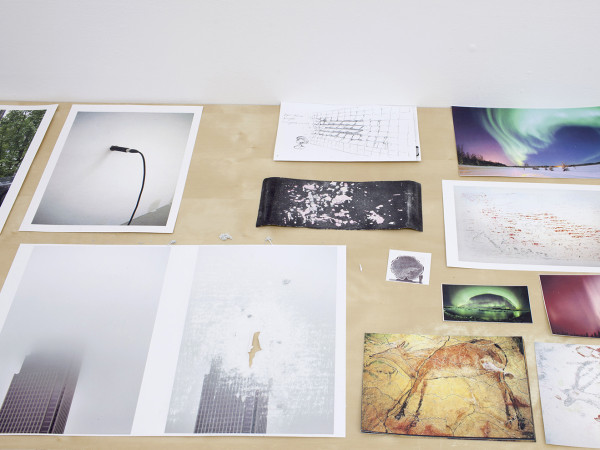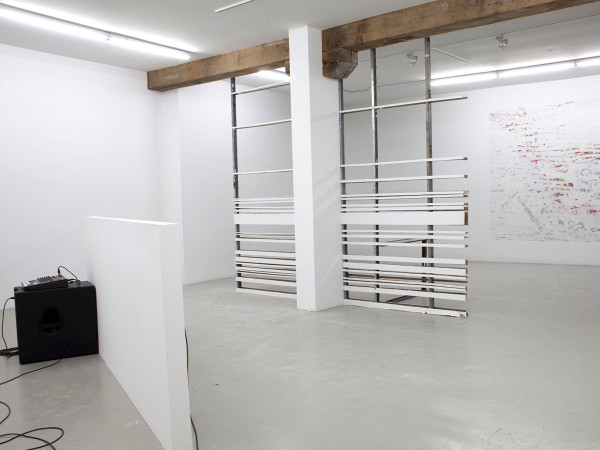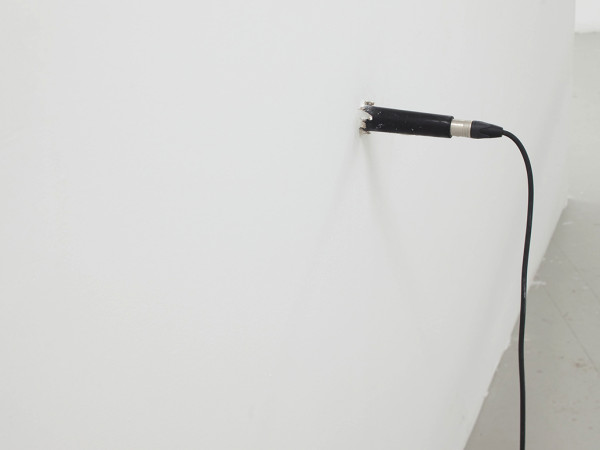Thoughts on Pablo Rasgado’s Phantoms
par Dominique Lepage
Pablo Rasgado
from November 20 to December 18, 2011
Invited to LA CHAMBRE BLANCHE, Pablo Rasgado chose not simply to perform in the gallery but to turn first to the historical riches that have accumulated within these same walls. Thus, he explored the files in the documentation centre to discover LA CHAMBRE BLANCHE’s history: all that has happened in this huge white gallery that at first glance reveals nothing of previous encounters with so many artists. However, Rasgado finds traces and brings them to light straight from the exhibition space, through its very materiality.
Beneath the white paint, he discovers layer after layer of mural paintings created by various artists and then covered over. In the centre of the gallery, where a partition sometimes was installed, a structure stands like a skeleton of a wall in which the proportions abide not by the constraints of construction but as a measure of time when the wall was present there. Finally, a portion of wall set up at the back of the space is arranged as a resonance chamber that vibrates with the sound and musical interventions presented in performance.
Rasgado gives his installation the evocative title of Phantoms. They are, in brief, LA CHAMBRE BLANCHE’s phantoms that he makes resurface and emerge in an ethereal, ghostly form. The appearance of the distant is close at hand, the past in the present. In this, one finds what Walter Benjamin called the “aura.” Works that can be reproduced are stripped down: their link to their distinctive history is no longer essential when they are freed from their origin in order to get closer to the viewer (whether one uses this copy rather than another does not change the experience that one has of a film, for example). The aura, ultimately linked to the cultural function of art in times gone by, belongs to a unique work that, through its presence, carries an historical weight within it, and everything that makes up this object. There is no equivalent in any reproduction, however much it conforms to the original. The in-situ work acquires such uniqueness by taking root in the place in which it is formed. Here, Rasgado has made visible the aura of LA CHAMBRE BLANCHE itself, both as a building and as an institution.
It is indeed the institution’s uniqueness as a physical space, as the place of an artistic event that the artist presents. LA CHAMBRE BLANCHE (The White Room) as the name says so well is a pristine space made available for artistic interventions. Always freshly painted white to receive new works, new encounters, new events; it is not however really pristine. The gallery has an extensive history and this can be covered up physically with layers of paint and by restructuring the space and so on. But only by forgetting can this history be eliminated.
A gallery that exhibits in-situ works must also be concerned with the ephemeral. The works appear here but then nothing is left in the end… except that when a work disappears in order to make room for another, the memory of it remains and there are traces that vouch for it. By summoning up the gallery’s history through the materiality of the space, the artist reveals the hidden past. He extracts the walls from the passivity in which he finds them, transforming them to make them speak (this is what the performance on “prepared wall” produces in a very concrete way, because it is the wall that produces its own resonances).
The past is also present but in a different form: its presence passes through memory. We could recall Saint Augustin, who in his Confessions questions the nature of time in order to find not three phases of time there but three kinds of present or presence. The past is thus the present time in memory – which differs from the present attention corresponding to what we call “the present”, and that of the waiting that corresponds to the future. This memory is fragile and to persist, it must be attached to more stable supports such as the narratives that one passes on of events, the literal documents, photographs and videos, monuments and so on: thus, the files conserved at LA CHAMBRE BLANCHE. These represent the continuity of the place, acting as a counterweight to the ephemeral space that is the exhibition gallery itself.
These are two aspects of LA CHAMBRE BLANCHE that Rasgado brought into dialogue, using the building’s materiality, the gallery walls, to reveal the institution’s duration. Here are the phantoms that he summons. In his installations, the past is present in a ghostly way: it appears, so to speak, in the presence of another kind than that of the present. This sends us back to the origin of the word “phantom”, derived from the Greek phantasma, which refers to an apparition, an image or an illusion, in this sense, the apparition has an unreal, even an immaterial nature. This is to say that by making LA CHAMBRE BLANCHE’s phantoms appear, the artist is not content to reveal the works and structures intact in their original form. They appear both again and in a new form, which shows the previous presence of these works as well as the passage of time that separates us from them. Today’s imaginary phantom also has this aspect: the presence of another kind, immateriality, light, reflection… More than unreal, it is of another reality, more diffuse and unstable as well. Nevertheless, the phantom moves in reality, and its presence intervenes here only by the fact of being perceived. Like the past that, in the vaporous form of memory, moves among us without always being noticed and emerges in broad daylight when it is attached to an appropriate support.
The sanded wall area –– fresco that, like an engraving, emerges from what the artist removes and not what he adds –– reveals under layers of recent paint the mural works produced earlier by Robbin Deyo (2009), Brad Buckley (2005) and the participants of Residence Story (2005) to name a few. The result is a visually poetic surface in which the fragile forms and colours of these meticulously recovered works are brought to light and come together. The image evokes a spectacular scene from Fellini’s film Roma, relating the archaeological discoveries that took place when the Rome subway was being constructed. Here the summoned group of archaeologists discover an underground hall decorated with wonderfully preserved ancient frescos but almost as soon as it is discovered, it started to crumble through contact with the air entering into the hall. As if the past is only preserved if kept from sight, as if the trace always threatens to evaporate. A terrible dilemma: either let the works keep their secret and preserve them by giving up the idea of seeing them, or else look at them on the condition of fully accepting their ephemeral nature. Orphic dilemma in short, Orpheus is allowed to bring back his beloved Eurydice from the Underworld on the condition of not looking at her before getting out of there, or he will loose her for good. Orpheus succumbed to the temptation and gave Eurydice a loving but fatal look. What can be said? Without a doubt, one cannot regain what is lost: that is to say, one cannot revive the past without altering it. And precisely, Rasgado makes the works from the past resurface in a gesture that uncovers them while avoiding their destruction, in a movement that reveals the past and the works’ fragility at the same time.
The wall structure evokes similar themes in other ways: one does not know when looking at it whether it is an unfinished construction or one in ruins. It is surely both, a construction in which the elements belong to right away to the past, a collection of bits of history, this time in symbolic form. It stands as a complex monument, offered in memory of earlier appearances of the place, to a wall that at times, is erected precisely on this spot and then again, is often not there. Once more, the past is expressed in its fragility through memory and its trace.
This fragility, moreover, is fully achieved when Rasgado’s installations in turn disappear. Was his memory work not right away doomed to vanish by its own destiny? Let us consider instead that it becomes part of the history of LA CHAMBRE BLANCHE and the signs of its ephemeral appearance are placed in the archives, as is the nature of all the works presented in situ. Rasgado’s work becomes part of the spirit of LA CHAMBRE BLANCHE in the awareness of its own temporality. But this will resonate only in those who accept the responsibility that memory involves. Here is one of the strong impressions that the installation leaves us with: the past is a delicate matter. In order not to be mutilated, perverted or lost, it requires serious study, patient and meticulous handling, and an alert and committed engagement. Rasgado succeeded in communicating this not only conceptually but also aesthetically. His work on time goes as far as making feelings resonate and through this, incites viewers think about the fragility of their existence. This is one of the work’s distinct qualities. On departing LA CHAMBRE BLANCHE after this visit, the installation is left behind but phantoms remain to haunt one.
Dominique Lepage


